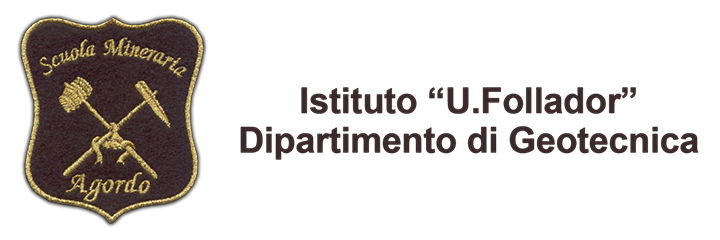Earth Trail: geology, local history and the use of rocks by man.
It runs mostly along the valley floor and is divided into the following tracks: San Lucano (Panel 3), Mezzavalle (Panel 4), La Calchera (Panel 5), Sentiero Cozzolino (Panel 6), Landslide of Prà and Lagunàz (Panel 7), Col di Prà (Panel 8), The "U" section (Panel 11), Pont (Panel 12)
Departure: Taibon Agordino
Length: 9 km;
Difference in altitude: about 550 meters
Travel time (on foot) a whole day.
Itinerary description
From the town hall of Taibon Agordino, proceed for 400 meters towards the locality of Pèden and then turn left towards Villanova.
After having left Villanova, cross on the other side of the village of Forno di Val; the toponym refers to the forges and furnaces deployed in metal processing in the area until the 19th century.
Just to the right outside the village, there is a short road branching off (700 meters from the fountain) that leads to an abandoned quarry where the debris discharged from the Roa del Forn gully was used.
From the road you can access the challenging CAI path no. 765 which goes up the austere Boral della Besausega and reaches the Bedin Shelter on the Prima Pala di San Lucano.
On the right side of the peak you can see the Bell Tower of Besausega, a rock tower rising for about thirty meters from the top ledge of the Seconda Pala, between the Boral della Besausega and the Boral del Mul.
Continue along the road along the Tegnàs creek; at the base of the Piaie de Prombiànch and upon reaching the junction for the Peschiere lake, continue on the main road that crosses the rim of the alluvial cone of the Boral della Besausega, completely covered by boulders and debris. Above the retaining wall damaged by rolled off rocks, there emerge organically blackened dolomite boulders. At the top on the orographic left of the Boral della Besausega you can see the "Piloi" of the mighty rock towers grayed by the vegetation that detach from the First Pala di San Lucano; they are like watches guarding the Boral della Besausega. This type of landscape is connected to the presence of a system of faults and fractures trending NE-SW that led to the erosion through exogenous agents.
A little further down the road, you can see an intake structure in which the waters of a spring known as "i Fontanoi'' are captured. It is a secondary water resurfacing - the water coming from the Pale di San Lucano, after having penetrated into the debris layer that surrounds the walls, resurface due to the lower permeability of alluvial deposits (sometimes sandy-silty) of the valley floor compared to groundwater and landslide debris. Other sources of the same type are present under the Piaie di Prombianch (source Prombianch) and just beyond the church of San Lucano (Scalette).
Once in the "picnic" area (900 m from the Peschiere junction), you can grasp the meaning of Dino Buzzati's phrase relating to the Pale di San Lucano:
… (And opposite, just beyond the more humble but no less awe-inspiring stream, the walls of the Pale di San Lucano stand)
(Dino Buzzati. “A roped team of three” in Corriere della Sera, June 23, 1956).
The vertical and overhanging walls of the Seconda Pala, more than 1300 meters high, loom over the road a short distance away; the immense fissure of the Boral di San Lucano appears further away. In front of the picnic area, a trace of a path winds towards the base of the Seconda Pala, initially on the slope of an abandoned quarry. Along the gully above, layers of the Agordo Formation emerge from which an interesting fossil flora of the Anisian period (247-242 million years ago) has been extracted.
Continuing for another 250 meters you will reach the church of San Lucano (200 m from the picnic area) where Panel 3 is located.
Continuing for another 250 meters you will reach the church of San Lucano (Panel 3).
From the church, continue along the road between the Tegnàs creek and the landslide scree with large boulders that extend to the base of the Pale. After about 700m you will reach a second picnic area with a splendid vista; mere 500 meters separate us from Mezzavalle (Panel 4).
Continue along the road from Mezzavalle with the “menacing” vertical wall (1400 meters high) of the Terza Pala di San Lucano - there are gigantic boulders overhanging along the slope.
After 700 meters you will reach an ancient lime kiln, called in the local dialect "calchera", recently cleaned by local volunteers, where Panel 5 is located
After visiting the "Calchera", continue on the road for about four hundred meters; on a boulder to the right of the roadway you can see a plaque commemorating the first ascent of Agnèr’s North Edge in 1921, by F. Jori, A. Zanutti, A. Andreoletti.
Fifty meters later, you can leave the main road and proceed on a side road which will allow you to cross the Tegnàs creek; take the path that leads to the Cozzolino shelter, at the base of the North Edge of Agnèr. The path will immediately become narrow and steep - not suitable for everyone - climbinh through a mass of landslides with gigantic boulders. This is the upper and surfacing part of a huge postglacial landslide coming from the Agnèr side, recognized, thanks to seismic surveys carried out in the valley, below the current topographical surface. In about 30 minutes of ascent you will reach a panoramic location towards the Pale di San Lucano (Panel 6).
Once the geological observations have been carried out, go back along the same path to the road at the bottom of the valley to proceed towards Col di Prà. After about three hundred meters you will arrive at the ruins of the hamlet of Prà, which bears witness to the landslide of Pra and Lagunaz in 1908. (Panel 7)
After roughly four hundred meters along the road and further into the valley, you will reach the town of Col di Prà, built on the edge of the alluvial fan of the Bordina stream, in full view of the north face of Mount Agnèr. Here, in the parking area, Panel 8 is located and it is possible to observe the North Edge of the Agner and the Frana del Piz.
From the Col di Prà car park, continue along the road towards Pont; after the temporary bridge that replaces the one torn off by the Bordina creek during the storm Vaia, continue climbing along the military road with a gentle and constant slope up to an altitude of 1088 m a.s.l., Panel 11.
Alternatively, after a few hundred meters from the first bend on the military road (where Panel 10 is located), you can take the CAI path no. 761 leading to Pont. Along the path there is a dispersed karst spring with a very variable regime, which usually disappears in dry summers. A little further on, you will have a distinct sensation of coolness - in fact a light flow of decidedly cold air comes out of a crack in the debris. We are on a large body of landslide (as we have seen it is a Deep Gravitative Slope Deformation). By all likelihood this crack is connected with the outside through a network of voids at a higher altitude. The cold winter air descends through the cavities drawing in new air from the surrounding area, the icy air flow continues to cool the underground environment thus creating ice deposits inside the cavities that continue to cool the air even in the advanced season flowing from above through the cracks in the rocks.
Proceed along the path until you cross the military road at an altitude of 1088 m a.s.l. where Panel 11 is located - a splendid vista is revealed over the large section between Terza Pala and Agnèr.
Proceed on the military road towards Pont and after about 500 meters you will reach the locality of Pont (1149 m asl) (Panel 12). There you can admire a beautiful waterfall carved in Morbiac Limestones; on the left bank you will find the remains of a long-abandoned mining activity.







